Frontline recruitment is relentless. You’re moving fast, trying to fill seats while your team keeps the day-to-day running.
Old habits like gut calls and guesswork only slow you down and add more stress.
Agentic AI is changing that. It’s making hiring smarter, faster, and more reliable.
This blog breaks down the biggest issues in high-volume hiring, like ghosting, no-shows, and burnout, and shows how the right tech is already making a difference.
Recruiting leaders who lean in see it as a way to protect their teams and bring new energy to the floor.
1. The Volume Problem: When Applications Pour In Faster Than You Can Read
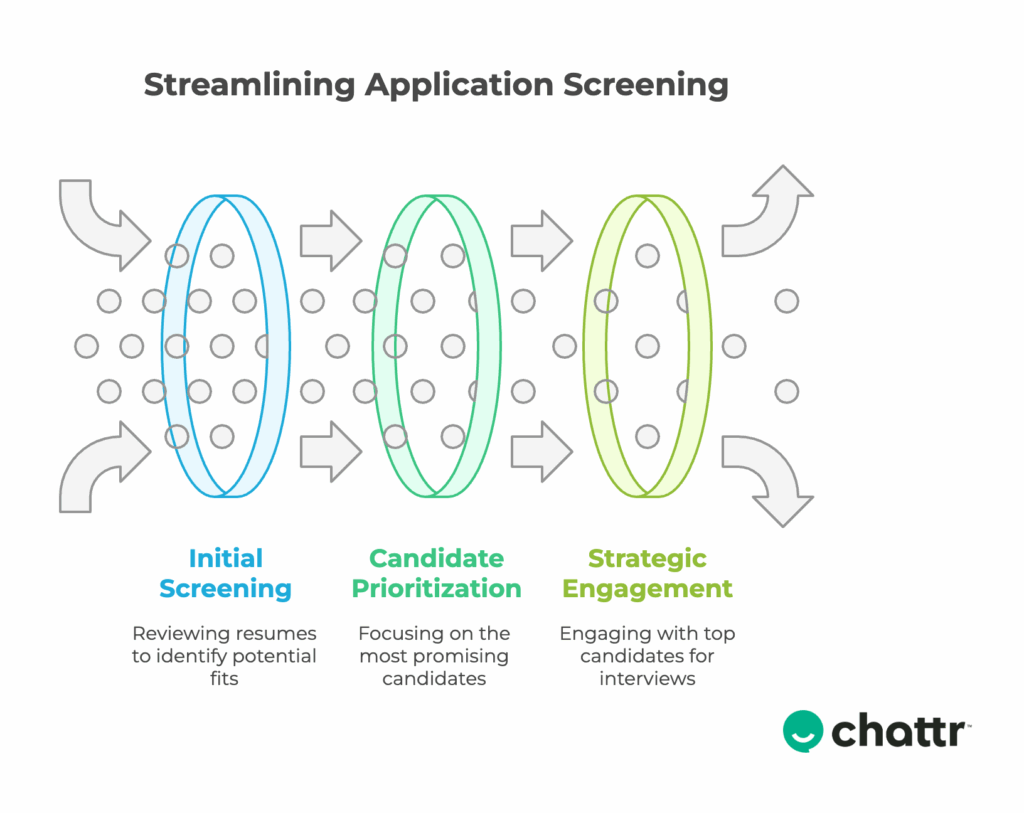
The Flood of Applications
High-volume frontline roles bring in a flood of resumes. Each listing draws in a mix of seasoned professionals, total beginners, and everyone in between.
The hiring team drowns in these applications, trying to keep up while balancing everything else they already handle.
Many of those resumes don’t fit the role, but each one still needs a glance.
The Breakdown in Screening
Traditional screening buckles under this load. Managers spend hours reviewing resumes that often miss the mark.
They read them in off-hours, skim to catch the basics, and still end up second-guessing if they’ve missed someone great.
It’s no wonder good candidates fall through the cracks or move on to a faster-moving competitor.
A Smarter Way to Filter
Automated, data-driven screening flips the script. It sorts out the noise and highlights real potential.
Tools that parse applications, check for key details, and prioritize promising candidates change how recruiting happens.
Instead of burning out on paperwork, your team can focus on connecting with the right people. When you cut out the back-and-forth and guesswork, you fill roles faster and with better fits.
The hiring process feels less like triage and more like strategy. That’s the difference between scrambling and leading.
2. Ghosting and No-Shows: When Silence Drains the Pipeline
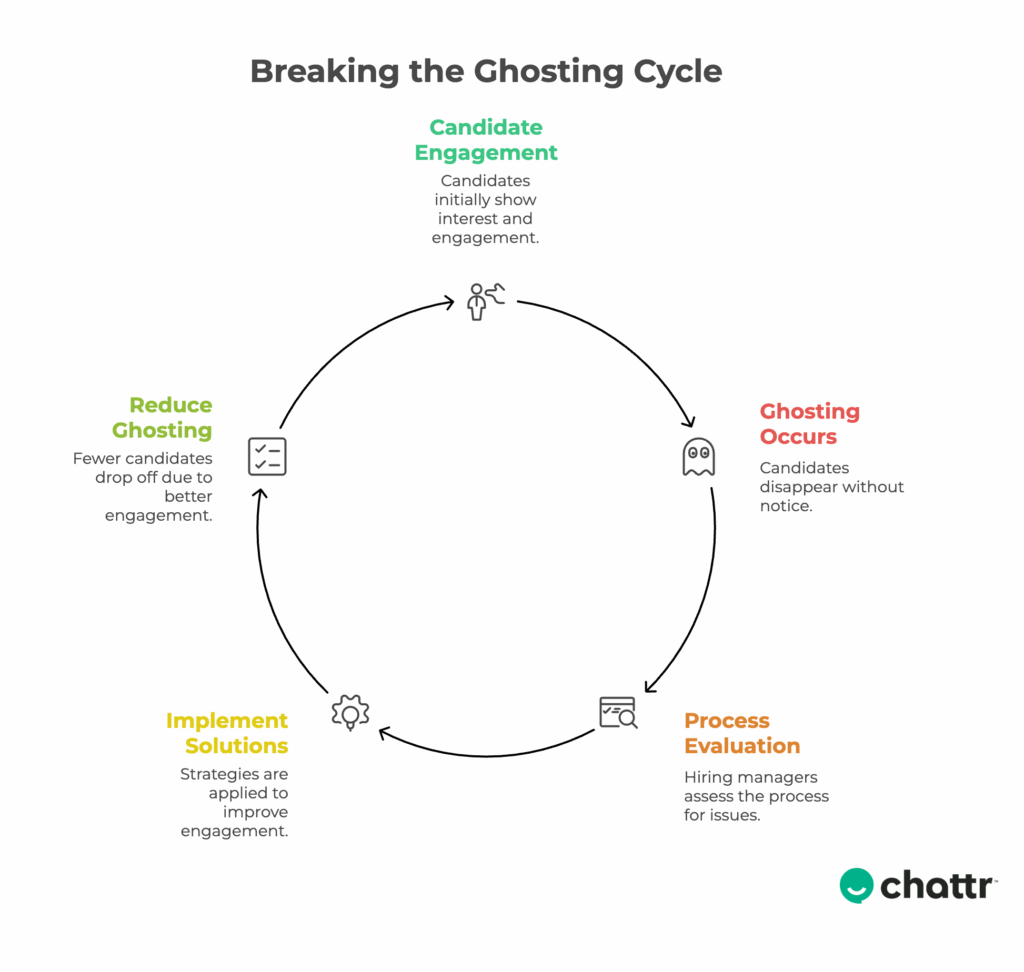
The Challenge: Silent Drop-Offs at Every Stage
Candidates start strong but vanish without a trace.
One moment they’re engaged, the next they’re gone, without notice or explanation.
This leaves hiring managers stuck in a loop of rescheduling and backfilling.
Missed interviews cost time and create stress for teams already working to the bone.
It’s a waste of energy and a drag on momentum.
Why It’s Happening
Ghosting is a sign your process isn’t connecting.
Candidates move on because they feel left out or undervalued.
They drop off when interviews take too long to schedule or when there’s no clear next step.
Many also leave when they find another offer that makes them feel wanted faster.
This is what happens when communication breaks down and your hiring process feels clunky.
How to Stop It: Real-Time Connection and Flexibility
- Let Candidates Own Their Schedule Self-scheduling tools let candidates pick the times that work for them. No waiting for callbacks or missed slots. Everyone shows up because they chose the time.
- Keep the Conversation Going Automated reminders and updates make sure no one’s left in the dark. When candidates feel seen, they’re more likely to stay engaged and show up.
- Set Expectations and Stick to Them Clear, upfront communication about the process makes people feel more invested. When they know what’s next, they’re more likely to commit.
With the right tools and mindset, you keep people engaged and reduce no-shows.
It’s how you turn ghosting from a problem to a rarity, so your hiring pipeline stays full and moving forward.
3. Speed vs. Quality: Hiring’s Tug of War
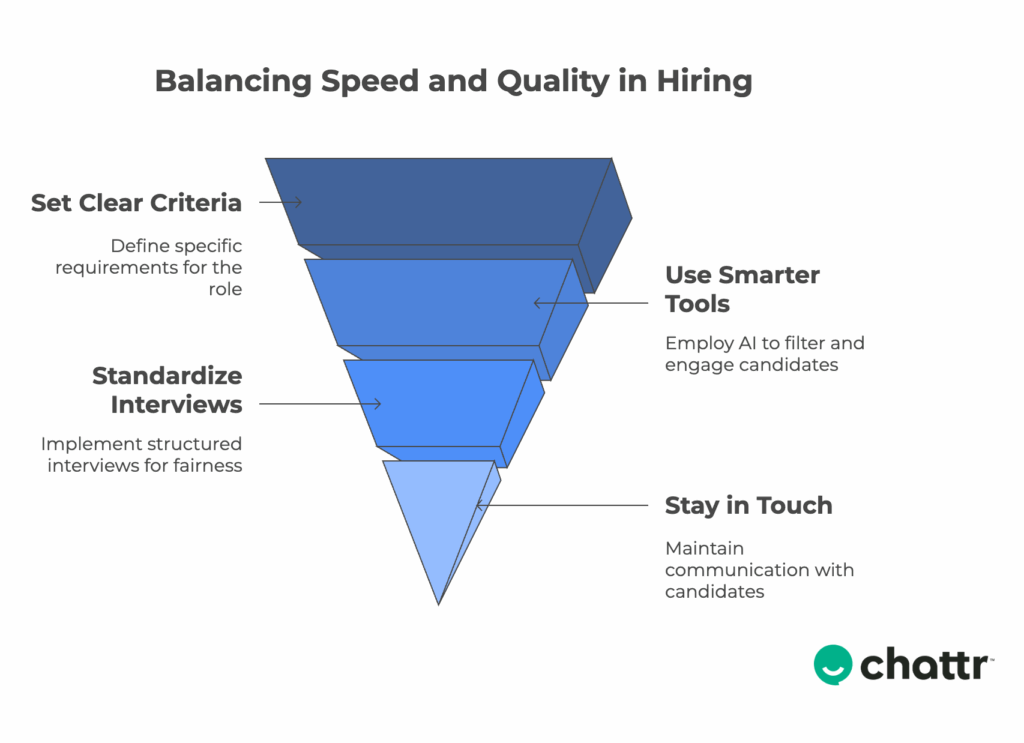
The Challenge: When Slow Means Losing and Fast Means Missing
Frontline recruiting is a race and a balancing act. Delay too long, and the best candidates vanish. Move too fast and you end up with the wrong hire.
Slow hiring leads to higher recruitment costs because ads run longer, recruiters spend more time, and schedules stretch.
Plus, top talent won’t wait. Long hiring processes hand them to your competitors, shrinking your pipeline and weakening your team.
The Cost of Getting it Wrong
Rushing also carries a price. The U.S. Department of Labor estimates that a bad hire costs 30% of their first-year pay.
That’s time and money gone in backfilling, retraining, and rebuilding team morale.
When the wrong person fills the role, you feel it fast.
Striking the Balance: Tips That Work
- Set Clear Criteria: Know exactly what you’re looking for. Get clear on skills, experience, and culture fit.
- Use Smarter Tools: AI-powered screening and tracking systems help filter candidates and keep the right ones engaged.
- Standardize Interviews: Use structured questions and scoring to cut bias and boost fairness.
- Stay in Touch: Keep candidates updated so they don’t wander off or lose interest.
Read More: Cost-Efficient Hourly Hiring: Reduce Expenses While Building Your Dream Team
4. Consistency and Compliance: The Cornerstones of Confident Hiring
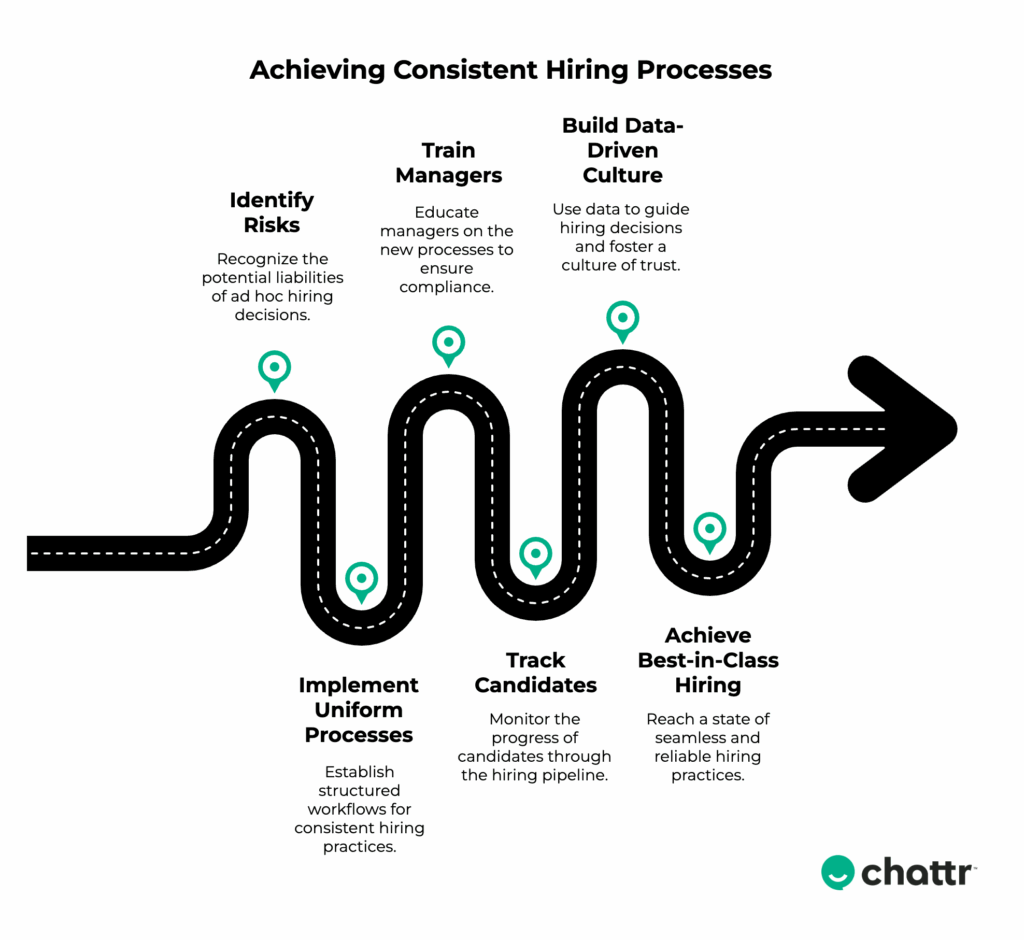
The Challenge: Ad Hoc Decisions Create Risk
When every store or site hires on the fly, you end up with a patchwork process. Managers pick shortcuts to save time, but that’s where problems start.
Inconsistencies creep in— from how interviews happen to who gets screened. Compliance slips through the cracks. For multi-location operators, this is a major liability.
Small oversights snowball. Regulations like predictive scheduling laws or fair workweek rules can lead to fines or lawsuits if you’re not buttoned up.
Why Uniform Processes Matter
Structured, repeatable workflows keep everyone on the same page.
When the process is clear— the same steps for every hire, every location— it’s easier to train managers and scale.
It’s easier to track who’s in the pipeline, how they’re moving, and what’s next.
No more “that’s how we’ve always done it.” You’ll end up with a clear path that works every time.
Building It In, Not Bolting It On
Smart hiring leaders build consistency right into the process. They lean on data to guide every step, from screening to offer.
This doesn’t just keep you out of legal trouble.
It’s how you build a culture of trust and reliability. When every team and every hire follows the same playbook, you protect your brand and set up every new team member for success.
That’s how you go from scattered to seamless, and from “good enough” to best in class.
5. Burnout in Frontline Hiring: The Hidden Cost of Doing It All
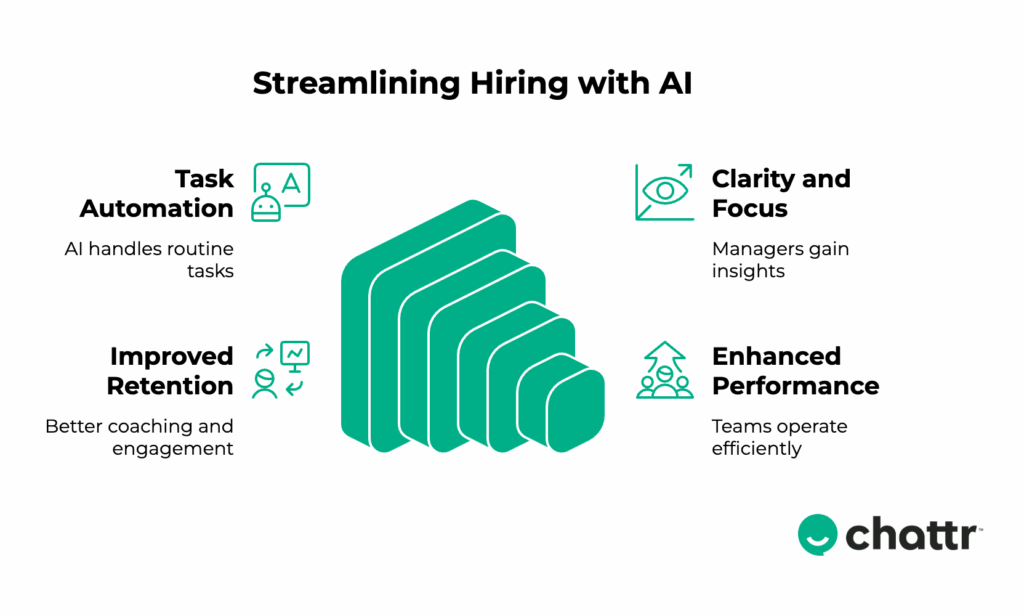
The Challenge: A Full Plate That’s Always Overflowing
For most frontline managers, hiring is a relentless extra job on top of an already demanding day. They’re reviewing applications on their breaks, tracking down no-shows after their shifts, and piecing together coverage for tomorrow’s gaps while still coaching today’s team.
This admin drag is hours lost every week that could have gone to the things that matter— like coaching new hires, fixing operational hiccups, or connecting with customers.
When the hiring process itself is a patchwork of manual tasks, burnout creeps in fast. Managers feel like they’re never caught up and never ahead.
Why It’s a Problem for Everyone
Manager burnout is a serious business risk.
When frontline leaders spend their days wrestling with endless admin, they’re not focused on retention or performance. They’re surviving, not leading.
Turnover grows because new hires don’t get the coaching they need. Teams get stuck in reactive cycles because no one has the time or energy to step back and spot patterns. The cycle doesn’t end when you replace one burned-out manager. It simply starts again.
In fast-moving industries, these gaps in leadership are felt immediately on the floor.
Redefining the Manager’s Role with AI
Agentic AI is built for exactly this kind of frontline environment. They cut the clutter.
It automates tasks such as screening, scheduling, and follow-ups, running them in the background. It lets managers see at a glance where every candidate is, who’s moving fast, and what’s slowing things down.
That clarity changes the game.
For recruiting leaders, this shift matters. This is how they protect their top talent and foster a culture where candidates want to stay.
6. Candidate Experience: Building a Better First Impression

The Challenge: A Process That Feels Like a Black Hole
In frontline hiring, candidates move fast. They’re applying to five roles at once and choosing the one that makes them feel valued from the start.
When your process is slow, disconnected, or leaves them guessing, you’re losing potential frontline champions.
It happens in small ways: an interview that never gets confirmed, an offer that sits unshared for days, a question that never gets answered.
These are all missed chances to show who you are as a company.
Why It Matters for Your Bottom Line
Every lost candidate in high-volume hiring is more than a missed headcount. It’s pressure back on your current team, it’s coverage gaps that ripple out to the customer, and it’s wasted dollars on sourcing that never turn into hires.
But beyond that, it’s your brand on the line.
Candidates remember the experience long after they’ve applied, whether they join your team or not. When they walk away feeling unheard or undervalued, that story doesn’t stay quiet.
In industries where reputation and referrals matter, that word-of-mouth shapes who applies next, how engaged new hires feel, and how fast you can keep your hiring engine running.
Data-Driven Insights and Real-Time Communication
A modern, agentic AI approach humanizes the process big time.
Real-time updates tell candidates where they stand, what’s next, and how they can engage. Clear data on where drop-offs happen gives you the roadmap to fix them before they become silent dealbreakers.
You don’t just throw automation at the problem.
You end up using data to meet candidates where they are: on their phones, between shifts, expecting clarity.
How Agentic AI Quietly Fits In

Frontline hiring doesn’t break down because of a lack of effort.
It breaks down because of too many moving parts and too little time.
That’s where agentic AI fits in. More as a quiet partner than a spotlight act. It adapts to the daily flow, the flood of resumes, and the on-the-floor realities that no dashboard can fully capture.
ChattrIQ is that partner for high-volume frontline teams.
It’s built into the Chattr platform and designed to handle the parts of hiring that slow you down, without getting in the way of your team’s instincts and culture.
At its core, Cora, your digital hiring assistant, listens to what’s happening in real time and recommends the best next step.
The Applicant View is where that starts. ChattrIQ ranks applicants by fit, using data from pre-screens, interviews, and even your team’s notes.
Cora jumps in to suggest the next step— maybe a phone interview for an average-fit applicant, or a final conversation for someone who’s clearly a standout. You decide which steps stay mandatory and how the pipeline looks.
ChattrIQ flexes to your rules, not the other way around.
The Candidate Profile goes deeper. It pulls together everything you’d want to know about an applicant— resumes, experience, even potential job matches you might not have thought of yet. Cora explains why a candidate ranks where they do, suggests whether to fast-track them or dig deeper, and keeps a real-time record of how they’re moving through your funnel.
For talent leaders juggling multiple locations, the Dashboard is where the bigger picture comes into focus.
Here, ChattrIQ shows you job summaries, pipeline health, and even flags urgent tasks like interviews that haven’t been scheduled or candidates who’ve gone dark. It does this with smart visuals and clear data.
The AI learns from what you do, adapts to your culture, and prioritizes what matters. Unlike static ranking tools, Cora doesn’t stop at the surface. It reads context— whether a candidate’s experience matches the demands of a tough shift, or how engagement might predict early performance.
It keeps an eye on bottlenecks that slow hiring down, whether it’s a delay in screening or a pattern of missed interviews.
Over time, it refines insights so that every next step feels more like a confident decision and less like another guess.
If you want to learn more about Chattr’s upcoming releases, feel free to book a demo right away!